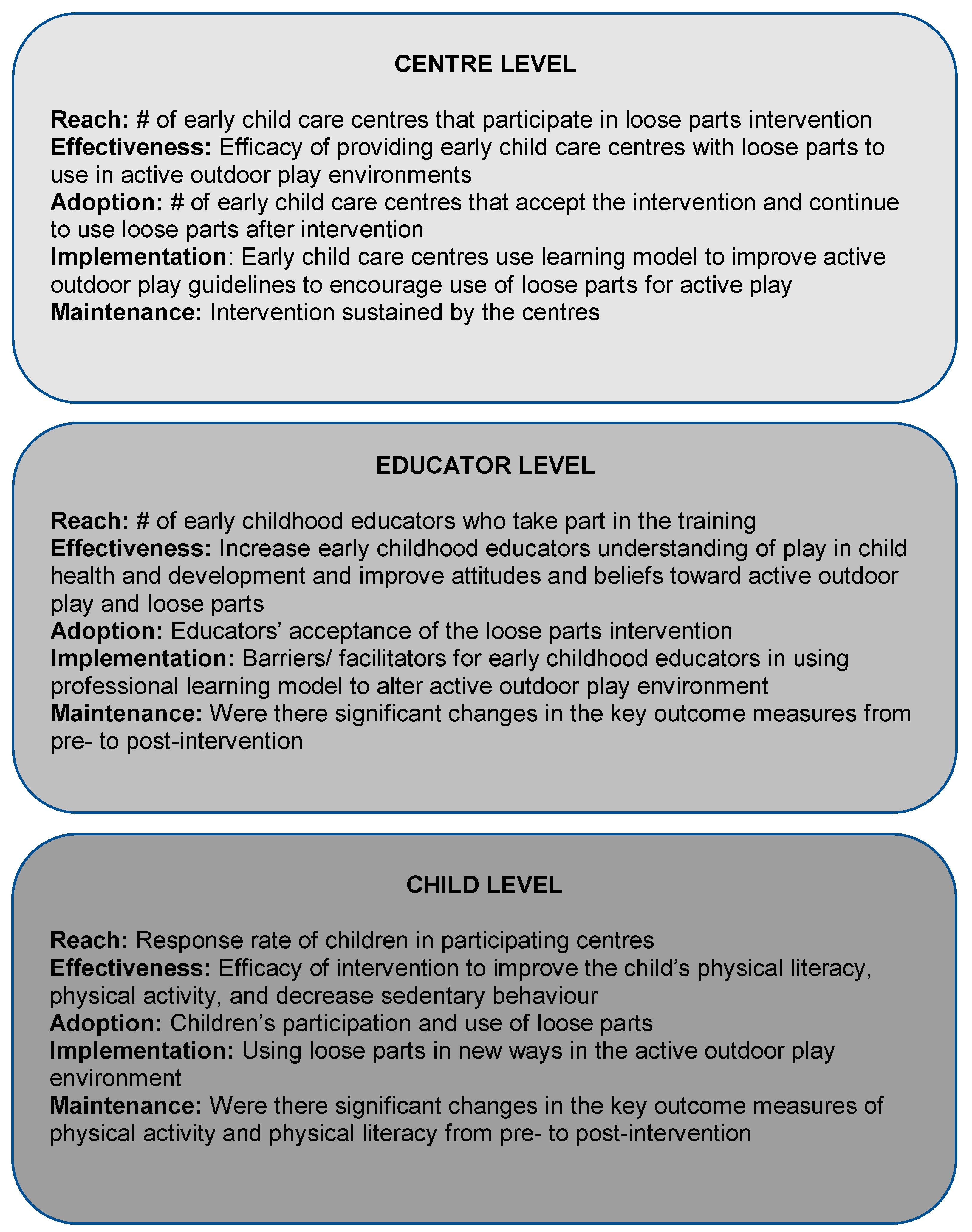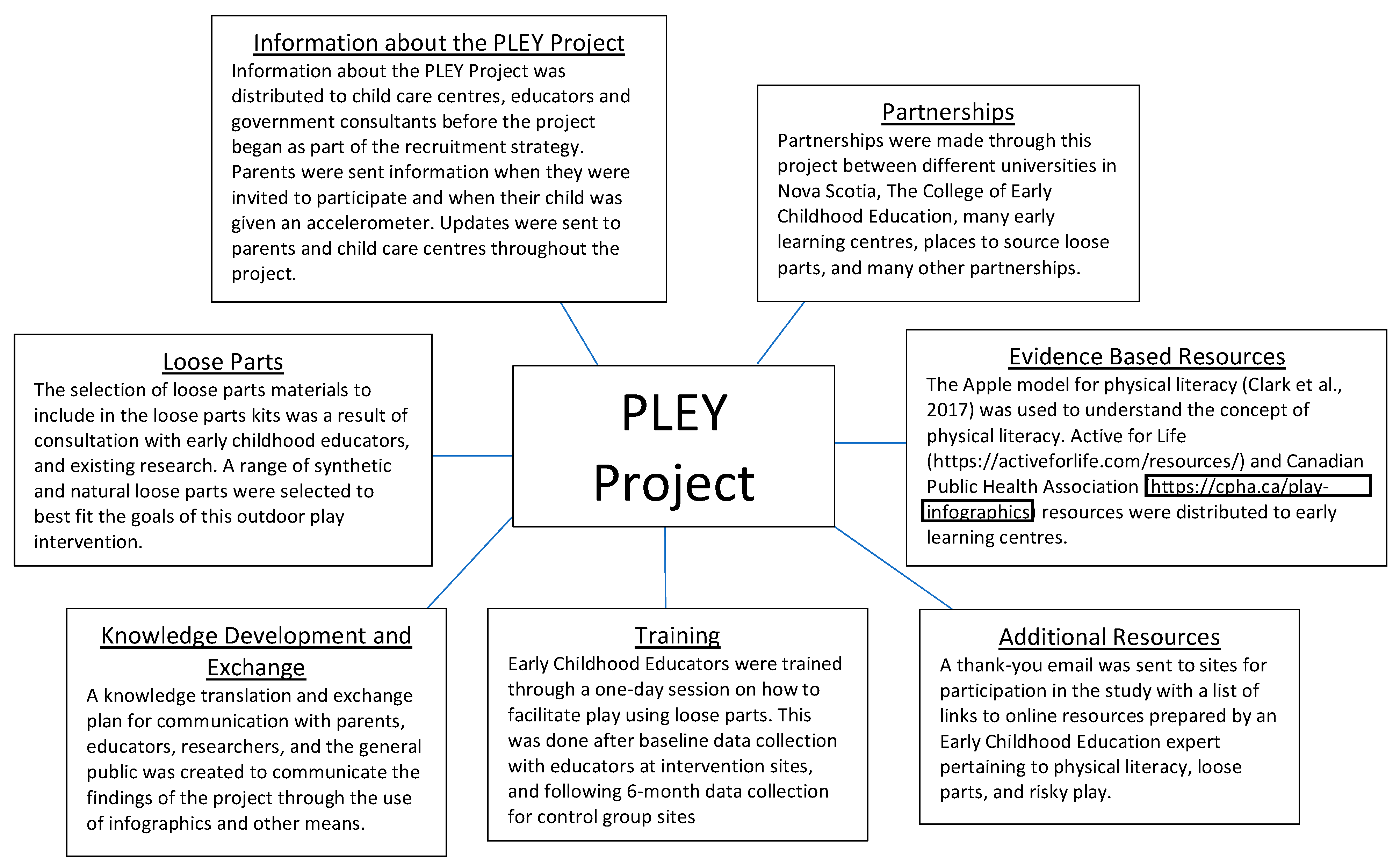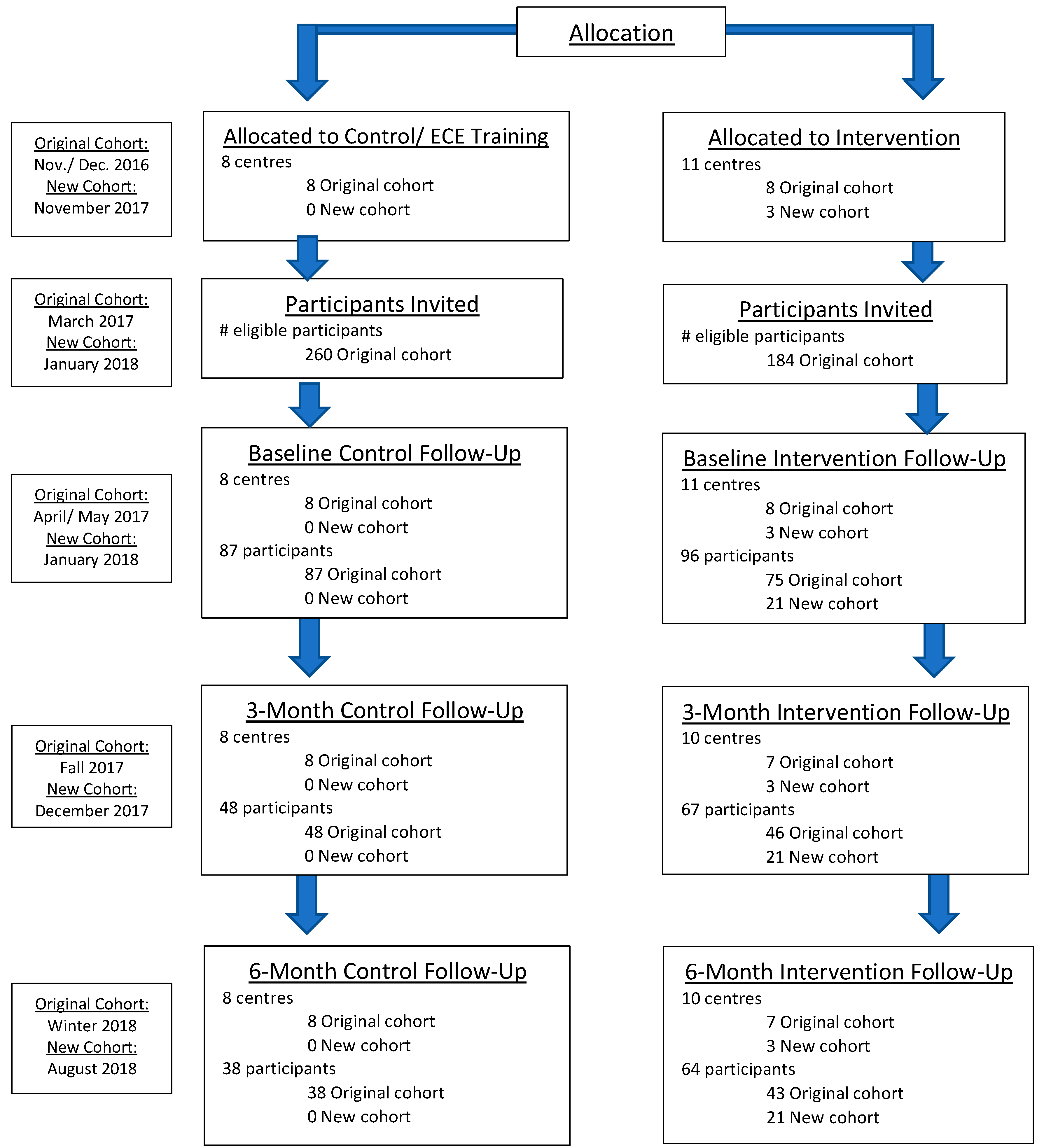A Loose Parts Randomized Controlled Trial to Promote Active Outdoor Play in Preschool-aged Children: Physical Literacy in the Early Years (PLEY) Project
Abstract
:1. Introduction
Study Objectives
- (1)
- improve children’s physical literacy, and increase time in PA and active outdoor play;
- (2)
- improve educators’ attitudes, beliefs, perceived competency, and intentions towards incorporating the intervention into practice;
- (3)
- increase parents’ and educators’ understanding of play in child health and development.
2. Experimental Design
2.1. The Intervention
2.2. Methods and Design
2.2.1. Study Design
2.2.2. Target Population and Sampling
3. Procedure
3.1. Children
3.1.1. Demographic and Body Composition
3.1.2. Physical Literacy
3.1.3. Physical Activity
3.2. Educators
3.2.1. Go NAP SACC Outdoor Play and Learning Self-Assessment Instrument
3.2.2. Site Context Questionnaire
3.2.3. Educator Training Session
3.2.4. Photo Documentation and Elicitation, and Focus Groups
3.3. Parents
3.3.1. Parent Survey
3.3.2. Parent Interviews
3.4. Data Analysis
4. Discussion
Author Contributions
Funding
Acknowledgments
Conflicts of Interest
References
- Janssen, I.; LeBlanc, A.G. Systematic Review of the Health Benefits of Physical Activity and Fitness in School-aged Children and Youth. Int. J. Behav. Nutr. Phys. Act. 2010, 7, 40. [Google Scholar] [CrossRef] [PubMed]
- Timmons, B.W.; LeBlanc, A.G.; Carson, V.; Gorber, S.C.; Dillman, C.; Janssen, I.; Kho, M.E.; Spence, J.C.; Stearns, J.A.; Tremblay, M.S. Systematic review of physical activity and health in the early years (aged 0–4 years). Appl. Physiol. Nutr. Metab. 2012, 37, 773–792. [Google Scholar] [CrossRef] [PubMed]
- Poitras, V.J.; Gray, C.E.; Borghese, M.M.; Carson, V.; Chaput, J.P.; Janssen, I.; Katzmarzyk, P.T.; Pate, R.R.; Connor Gorber, S.; Kho, M.E.; et al. Systematic review of the relationships between objectively measured physical activity and health indicators in school-aged children and youth. Appl. Physiol. Nutr. Metab. 2016, 41, 197–239. [Google Scholar] [CrossRef]
- Carson, V.; Lee, E.-Y.; Hewitt, L.; Hunter, S.; Jennings, C.; Kuzik, N.; Stearns, J.; Unrau Powley, S.; Poitras, V.; Gray, C.E.; et al. Systematic review of the relationships between physical activity and health indicators in the early years (aged 0–4 years). BMC Public Health 2017, 17 (Suppl. 5), 854. [Google Scholar] [CrossRef]
- Epstein, L.H.; Roemmich, J.N.; Robinson, J.L.; Paluch, R.A.; Winiewicz, D.D.; Fuerch, J.H.; Robinson, T.N. A randomized trial of the effects of reducing television viewing and computer use on body mass index in young children. Arch. Pediatr. Adolesc. Med. 2008, 162, 239–245. [Google Scholar] [CrossRef] [PubMed]
- Chaput, J.-P.; Gray, C.E.; Poitras, V.J.; Carson, V.; Gruber, R.; Birken, C.S.; MacLean, J.E.; Aubert, S.; Sampson, M.; Tremblay, M.S. Systematic review of the relationships between sleep duration and health indicators in the early years (0–4 years). BMC Public Health 2017, 17, 855. [Google Scholar] [CrossRef]
- Kuzik, N.; Carson, V. The association between physical activity, sedentary behavior, sleep, and body mass index z-scores in different settings among toddlers and preschoolers. BMC Pediatr. 2016, 16, 100. [Google Scholar] [CrossRef]
- Chaput, J.-P.; Colley, R.C.; Aubert, S.; Carson, V.; Janssen, I.; Roberts, K.C.; Tremblay, M.S. Proportion of preschool-aged children meeting the 24-hour Movement Guidelines and associations with adiposity: Results from the Canadian Health Measures Survey. BMC Public Health 2017, 17, 829. [Google Scholar] [CrossRef] [PubMed]
- Kuzik, N.; Poitras, V.J.; Tremblay, M.S.; Lee, E.-Y.; Hunter, S.; Carson, V. Systematic review of the relationships between combinations of movement behaviors and health indicators in the early years (aged 0 to 4 years). BMC Public Health 2017, 17 (Suppl. 5), 849. [Google Scholar] [CrossRef] [PubMed]
- Tremblay, M.S.; Chaput, J.-P.; Adamo, K.B.; Aubert, S.; Barnes, J.D.; Choquette, L.; Duggan, M.; Faulkner, G.; Goldfield, G.S.; Gray, C.E.; et al. Canadian 24-h movement guidelines for the early years (0–4 years): An integration of physical activity, sedentary behavior, and sleep. BMC Public Health 2017, 17 (Suppl. 5), 874. [Google Scholar] [CrossRef]
- Tremblay, M.S.; Carson, V.; Chaput, J.-P.; Dinh, T.; Duggan, M.; Faulkner, G.; Connor Gorber, S.; Gray, C.E.; Gruber, R.; Janson, K.; et al. Canadian 24-h movement guidelines for children and youth: An integration of physical activity, sedentary behavior, and sleep. Appl. Physiol. Nutr. Metab. 2016, 41, 311–327. [Google Scholar] [CrossRef]
- Garriguet, D.; Carson, V.; Colley, R.C.; Janssen, I.; Timmons, B.W.; Tremblay, M.S. Physical activity and sedentary behavior of Canadian children aged 3 to 5. Health Rep. 2016, 27, 14–23. [Google Scholar]
- Bingham, D.D.; Costa, S.; Hinkley, T.; Shire, K.A.; Clemes, S.A.; Barber, S.E. Physical activity during the early years: A systematic review of correlates and determinants. Am. J. Prev. Med. 2016, 51, 384–402. [Google Scholar] [CrossRef]
- Hinkley, T.; Crawford, D.; Salmon, J.; Okely, A.D.; Hesketh, K. Preschool children and physical activity: A review of correlates. Am. J. Prev. Med. 2008, 34, 435–441. [Google Scholar] [CrossRef]
- De Craemer, M.; De Decker, E.; De Bourdeaudhuij, I.; Vereecken, C.; Deforche, B.; Manios, Y.; Cardon, G. Correlates of energy balance-related behaviors in preschool children: A systematic review. Obes. Rev. 2012, 13, 13–28. [Google Scholar] [CrossRef]
- Brussoni, M.; Olsen, L.L.; Pike, I.; Sleet, D.A. Risky play and children’s safety: Balancing priorities for optimal child development. Int. J. Environ. Res. Public Health 2012, 9, 3134–3148. [Google Scholar] [CrossRef]
- Gray, C.; Gibbons, R.; Larouche, R.; Sandseter, E.B.; Bienenstock, A.; Brussoni, M.; Chabot, G.; Herrington, S.; Janssen, I.; Pickett, W.; et al. What is the relationship between outdoor time and physical activity, sedentary behavior, and physical fitness in children? A systematic review. Int. J. Environ. Res. Public Health 2015, 12, 6455–6474. [Google Scholar] [CrossRef]
- Bassett, D.R.; John, D.; Conger, S.A.; Fitzhugh, E.C.; Coe, D.P. Trends in physical activity and sedentary behaviors of U.S. youth. J. Phys. Act. Health 2015, 12, 1102–1111. [Google Scholar] [CrossRef]
- Veitch, J.; Bagley, S.; Ball, K.; Salmon, J. Where do children usually play? A qualitative study of parents’ perceptions of influences on children’s active free-play. Health Place 2006, 12, 383–393. [Google Scholar] [CrossRef] [PubMed]
- Active Healthy Kids Canada (AHKC). The Active Healthy Kids Canada 2012 Report Card on Physical Activity for Children and Youth; Active Healthy Kids Canada: Toronto, ON, Canada, 2012. [Google Scholar]
- Valentine, G.; McKendrck, J. Children’s outdoor play: Exploring parental concerns about children’s safety and the changing nature of childhood. Geoforum 1997, 28, 219–235. [Google Scholar] [CrossRef]
- Tremblay, M.S.; Gray, C.; Babcock, S.; Barnes, J.; Bradstreet, C.C.; Carr, D.; Chabot, G.; Choquette, L.; Chorney, D.; Collyer, C.; et al. Position statement on active outdoor play. Int. J. Environ. Res. Public Health 2015, 12, 6474–6505. [Google Scholar] [CrossRef]
- Tucker, P.; Vanderloo, L.M.; Johnson, A.M.; Burke, S.M.; Irwin, J.D.; Gaston, A.; Driediger, M.; Timmons, B.W. Impact of the supporting physical activity in the childcare environment (SPACE) intervention on preschoolers’ physical activity levels and sedentary time: A single-blind cluster randomized controlled trial. Int. J. Behav. Nutr. Phys. Act. 2017, 14, 120. [Google Scholar] [CrossRef]
- Vanderloo, L.M.; Tucker, P. Weekly trends in preschoolers’ physical activity and sedentary time in childcare. Int. J. Environ. Res. Public Health 2015, 12, 2454–2464. [Google Scholar] [CrossRef]
- Bushnik, T. Child Care in Canada. Children and Youth Research Paper Series. 2006, pp. 1–99. Available online: http://publications.gc.ca/Collection/Statcan/89-599-MIE/89-599-MIE2006003.pdf (accessed on 3 April 2019).
- Goldfield, G.S.; Harvey, A.L.J.; Grattan, K.P.; Temple, V.; Naylor, P.-J.; Alberga, A.S.; Ferraro, Z.M.; Wilson, S.; Cameron, J.D.; Barrowman, N.; et al. Effects of child care intervention on physical activity and body composition. Am. J. Prev. Med. 2016, 51, 225–231. [Google Scholar] [CrossRef]
- Foulkes, J.D.; Knowles, Z.; Fairclough, S.J.; Stratton, G.; O’Dwyer, M.; Ridgers, N.D.; Foweather, L. Effect of a 6-week active play intervention on fundamental movement skill competence of preschool children. Percept. Mot. Skills 2017, 124, 393–412. [Google Scholar] [CrossRef] [PubMed]
- ParticipACTION; Sport for Life Society; The Healthy Active Living and Obesity Research Group at the Children’s Hospital of Eastern Ontario Research Institute; Physical and Health Education Canada; Canadian Parks and Recreation Association; The Ontario Society of Physical Activity Promoters in Public Health. Physical Literacy Consensus Statement; ParticipACTION: Toronto, ON, Canada, 2015. [Google Scholar]
- International Physical Literacy Association (IPLA). Defining Physical Literacy; England, UK, 2014; Available online: https://www.physical-literacy.org.uk (accessed on 2 April 2019).
- Castelli, D.M.; Barcelona, J.M.; Bryant, L. Contextualizing physical literacy in the school environment: The challenges. J. Sport Health Sci. 2015, 4, 156–163. [Google Scholar] [CrossRef]
- Adamo, K.B.; Barrowman, N.; Naylor, P.J.; Yaya, S.; Harvey, A.; Grattan, K.P.; Goldfield, G.S. Activity Begins in Childhood (ABC)—Inspiring healthy active behavior in preschoolers: Study protocol for a cluster randomized controlled trial. Trials 2014, 15, 305. [Google Scholar] [CrossRef]
- Belanger, M.; Humbert, L.; Vatanparast, H.; Ward, S.; Muhajarine, N.; Froehlich Chow, A.; Engler-Stringer, R.; Donovan, D.; Carrier, N.; Leis, A. A multilevel intervention to increase physical activity and improve healthy eating and physical literacy among young children (ages 3–5) attending early childcare centres: The Healthy Start-Depart Sante cluster randomized controlled trial study protocol. BMC Public Health 2016, 16, 313. [Google Scholar] [CrossRef] [PubMed]
- ParticipACTION. The Biggest Risk Is Keeping Kids Indoors; The 2015 ParticipACTION Report Card on Physical Activity for Children and Youth; ParticipACTION: Toronto, ON, USA, 2015. [Google Scholar]
- Nicholson, S. How not to cheat children: The theory of loose parts. Landsc. Arch. 1971, 62, 30–34. [Google Scholar]
- Maxwell, L.E.; Mitchell, M.R.; Evans, G.W. Effects of play equipment and loose parts on preschool children’s outdoor play behavior: An observational study and design intervention. Child Youth Environ. 2008, 18, 36–63. [Google Scholar]
- Houser, N.E.; Roach, L.; Stone, M.R.; Turner, J.; Kirk, S.F.L. Let the children play: Scoping review on the implementation and use of loose parts for promoting physical activity participation. AIMS Public Health 2016, 3, 781–799. [Google Scholar] [CrossRef]
- McLeroy, K.R.; Bibeau, D.; Steckler, A.; Glanz, K. An ecological perspective on health promotion programs. Health Educ. Q. 1988, 4, 156–163. [Google Scholar] [CrossRef]
- Austin, G.; Bell, T.; Caperchione, C.; Mummery, W.K. Translating research to practice: Using the RE-AIM framework to examine an evidence-based physical activity intervention in primary school settings. Health Promot. Pract. 2011, 12, 932–941. [Google Scholar] [CrossRef]
- Donath, I.; Faude, O.; Hagmann, S.; Roth, R.; Zahner, L. Fundamental movement skills in preschoolers: A randomized controlled trial targeting object control proficiency. Child Care Health Dev. 2015, 41, 1179–1187. [Google Scholar] [CrossRef]
- Wasenius, N.S.; Grattan, K.P.; Harvey, A.L.J.; Naylor, P.-J.; Goldfield GSl Adamo, K.B. The effect of a physical activity intervention on preschoolers’ fundamental motor skills—A cluster RCT. J. Sci. Med. Sport 2018, 21, 714–719. [Google Scholar] [CrossRef] [PubMed]
- Gordon, E.S.; Tucker, P.; Burke, S.M.; Carron, A.V. Effectiveness of physical activity interventions for preschoolers: A Meta-Analysis. Res. Q. Exerc. Sport 2013, 84, 287–294. [Google Scholar] [CrossRef]
- Ulrich, D. The Test of Gross Motor Development—Third Edition (TGMD-3: Administration, scoring, and international norms. Spor Bilimleri Derg. 2013, 24, 27–33. [Google Scholar]
- Sun, S.H.; Zhu, Y.C.; Shih, C.L.; Lin, C.H.; Wu, S.K. Development and initial validation of the Preschooler Gross Motor Quality Scale. Res. Dev. Disabil. 2010, 31, 1187–1196. [Google Scholar] [CrossRef] [PubMed]
- Carson, V.; Rahman, A.A.; Wiebe, S.A. Associations of objectively measured sedentary behavior and physical activity with cognitive development in the early years. Ment. Health Phys. Act. 2017, 13, 1–8. [Google Scholar] [CrossRef]
- Hinkley, T.; O’Connell, E.; Okely, A.D.; Crawford, D.; Hesketh, K.; Salmon, J. Assessing volume of accelerometer data for reliability in preschool children. Med. Sci. Sports Exerc. 2012, 44, 2436–2441. [Google Scholar] [CrossRef] [PubMed]
- Janssen, X.; Cliff, D.P.; Reilly, J.J.; Hinkley, T.; Jones, R.A.; Batterham, M.; Ekelund, U.; Brage, S.; Okely, A.D. Predictive validity and classification accuracy of ActiGraph energy expenditure equations and cut-points in young children. PLoS ONE 2013, 8, e79124. [Google Scholar] [CrossRef]
- Ward, D.; Morris, E.; McWilliams, C.; Vaughn, A.; Erinosho, T.; Mazzucca, S.; Hanson, P.; Ammerman, A.; Neelon, S.; Sommers, J.; et al. Go NAP SACC: Nutrition and Physical Activity Self-Assessment for Child Care, 2nd ed.; Center for Health Promotion and Disease Prevention and Department of Nutrition, University of North Carolina at Chapel Hill: Chapel Hill, NC, USA, 2014. [Google Scholar]
- Ward, D.; Hales, D.; Haverly, K.; Marks, J.; Benjamin, S.; Ball, S.; Trost, S. An instrument to assess the obesogenic environment of child care centres. Am. J. Health Behav. 2008, 32, 380–386. [Google Scholar] [CrossRef] [PubMed]
- Hayball, F.Z.; Pawlowski, C.S. Using participatory approaches with children to better understand their physical activity behaviour. Health Educ. J. 2018, 77, 542–554. [Google Scholar] [CrossRef] [PubMed]
- Epstein, I.; Stevens, B.; McKeever, P.; Baruchel, S. Photo Elicitation Interview (PEI): Using Photos to elicit children’s perspectives. Int. J. Qual. Methods 2006, 5, 1–11. [Google Scholar] [CrossRef]
- Mandleco, B. Research with children as participants: Photo elicitation. J. Spec. Pediatr. Nurs. 2013, 18, 78–82. [Google Scholar] [CrossRef] [PubMed]
- Pyle, A. Engaging young children in research through photo elicitation. Early Child. Dev. Care 2013, 183, 1544–1558. [Google Scholar] [CrossRef]
- Adamo, K.B.; Wasenius, N.S.; Grattan, K.P.; Harvey, A.L.J.; Naylor, P.-J.; Barrowman, N.J.; Goldfield, G.S. Effects of a preschool intervention on physical activity and body composition. J. Pediatr. 2017, 188, 42–49. [Google Scholar] [CrossRef]



© 2019 by the authors. Licensee MDPI, Basel, Switzerland. This article is an open access article distributed under the terms and conditions of the Creative Commons Attribution (CC BY) license (http://creativecommons.org/licenses/by/4.0/).
Share and Cite
Houser, N.E.; Cawley, J.; Kolen, A.M.; Rainham, D.; Rehman, L.; Turner, J.; Kirk, S.F.L.; Stone, M.R. A Loose Parts Randomized Controlled Trial to Promote Active Outdoor Play in Preschool-aged Children: Physical Literacy in the Early Years (PLEY) Project. Methods Protoc. 2019, 2, 27. https://doi.org/10.3390/mps2020027
Houser NE, Cawley J, Kolen AM, Rainham D, Rehman L, Turner J, Kirk SFL, Stone MR. A Loose Parts Randomized Controlled Trial to Promote Active Outdoor Play in Preschool-aged Children: Physical Literacy in the Early Years (PLEY) Project. Methods and Protocols. 2019; 2(2):27. https://doi.org/10.3390/mps2020027
Chicago/Turabian StyleHouser, Natalie E., Jane Cawley, Angela M. Kolen, Daniel Rainham, Laurene Rehman, Joan Turner, Sara F. L. Kirk, and Michelle R. Stone. 2019. "A Loose Parts Randomized Controlled Trial to Promote Active Outdoor Play in Preschool-aged Children: Physical Literacy in the Early Years (PLEY) Project" Methods and Protocols 2, no. 2: 27. https://doi.org/10.3390/mps2020027
APA StyleHouser, N. E., Cawley, J., Kolen, A. M., Rainham, D., Rehman, L., Turner, J., Kirk, S. F. L., & Stone, M. R. (2019). A Loose Parts Randomized Controlled Trial to Promote Active Outdoor Play in Preschool-aged Children: Physical Literacy in the Early Years (PLEY) Project. Methods and Protocols, 2(2), 27. https://doi.org/10.3390/mps2020027





